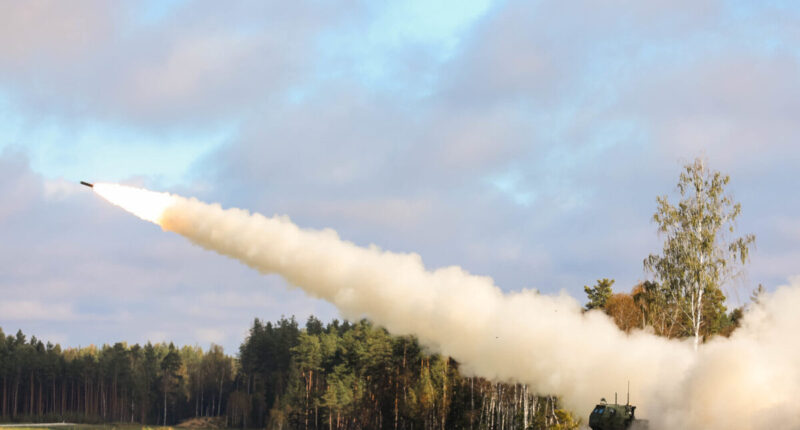President Donald Trump was reportedly caught “flat-footed” when the Pentagon abruptly announced it was freezing shipments of critical weapons to Ukraine, including Patriot missile interceptors, precision-guided GMLRS, and artillery rounds.
The rationale for halting shipments of defensive weapons to Ukraine stems from a review that found that the U.S. only has about 25 percent of the Patriot interceptors needed for all Defense Department military plans.
Yet just days later, Trump reversed course. “They’re getting hit very hard now,” he said. “We’re going to send some more weapons — defensive weapons primarily.”
The rapid pivot back to arms transfers to Ukraine illustrates just how deeply embedded interventionist reflexes remain not just in Congress and the Pentagon, but even within Trump’s own orbit.
US Running Low
At the center of this internal tug-of-war is Under Secretary of Defense for Policy Elbridge Colby, a leading voice for a more restrained, realist approach to America’s military posture, which is a position that has reportedly frustrated some hawkish members within the Trump administration.
Colby has warned that U.S. weapons stockpiles are running low, defense manufacturing is lagging behind adversaries, and that it is time for Europe to take primary responsibility for Ukraine, while America focuses on shoring up its limited resources by preparing for a far more dangerous geopolitical challenge: China.
A recent analysis by Foreign Affairs aligns with Colby’s assessment, stating that the United States “has low stockpiles of munitions, its ships and planes are older than China’s, and its industrial base lacks the capacity to regenerate these assets. In war games that simulate a conflict in the Taiwan Strait, Washington runs out of key munitions within weeks.”
The U.S. Air Force’s fleet is showing its age, with planes averaging 32 years old, and some exceeding 50 years. Developing new major weapons platforms like these can take more than eight years, however if the F-22 Raptor is any indication, the process could take more than 15 years.
The U.S. Navy is in an equally perilous situation. Though the average U.S. naval vessel is 19 years old, some vessels like cruisers are pushing almost 30 years old. To meet future demand, the Navy may require extending the lives of some non-nuclear surface ships to over 50 years old.
In stark contrast, 70 percent of China’s naval ships have been launched since 2010. China’s annual shipbuilding capacity is an astounding 26 million tons, which is 370 times greater than the United States’ capacity of 70,000 tons. The U.S. industrial capacity is so limited that it cannot even produce a single 100,000-ton Ford-class aircraft carrier annually.
Still, Washington clings to a WWII-era fantasy, believing that it can arm the world while neglecting its own arsenal.
Two Systems in Low Supply
Two systems that are in high demand and low supply are the National Advanced Surface-to-Air Missile System (NASAM) that Ukraine can’t get enough of, and the GBU-57 Massive Ordnance Penetrators that were recently used in coordination with Israel against Iranian nuclear sites.
It takes around two years to manufacture and deploy a NASAM battery, which is capable of launching 72 missiles into the sky at once and is jointly produced by Norwegian Kongsberg Defence & Aerospace and U.S. RTX Corporation.
Why so long? While Kongsberg, like most Western defense firms, designs and assembles its weapons systems, it doesn’t manufacture most of the components in house. Unlike the mass production lines that made the weapons used to fight World War II, more than 1,500 suppliers across two continents contribute to the weapons produced at just one Kongsberg factory, with the U.S. defense contractor RTX supplying the radar and the actual missiles.
In terms of the 30,000-pound GBU-57 Massive Ordnance Penetrators (MOP), the situation is even worse.
Before Trump’s airstrikes on Iran, the United States possessed only 20 MOP bombs, however 14 of these were expended on two targets in Iran, leaving only six. According to National Interest, it took more than a decade to produce the initial 20 GBU-57s, and their production line has been closed while the Pentagon currently awaits bids from American defense contractors for a Next Generation Penetrator (NGP) contract.
Embracing Realism
The truth is simple: the United States is under no obligation to indefinitely bankroll Ukraine’s war effort or come to Israel’s defense, especially not at the expense of our own military readiness.
These weapon systems are not only costly, but limited in their ability to be mass produced, and should be reserved first and foremost for the defense of American troops in any future conflict. It’s long overdue for the United States to reevaluate its foreign policy and embrace a path of prudent foreign policy realism, while focusing on rearmament through reindustrialization.
This is not isolationism, it’s prioritization. A foreign policy rooted in realism begins by recognizing limits: of production, of attention, and perhaps most of all, of obligation.
Rebuilding American strength starts at home, not in Kyiv, not in Tel Aviv, and not in another foreign aid or weapons package.
America will not compete in the 21st century if it’s stuck in a 20th-century mindset.








